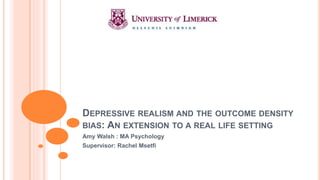Report
Share

Recommended
Recommended
This is a quantitative study conducted in Sri Lanka using a sample size of 137 executives in the private sector. Findings can be useful when designing stress management interventions and recruitment and selection process.Mediating Effect of Primary Coping Strategies in the relationship between Big...

Mediating Effect of Primary Coping Strategies in the relationship between Big...Jayamini D Samarathunge
More Related Content
Similar to Presentation- Conference PSU
This is a quantitative study conducted in Sri Lanka using a sample size of 137 executives in the private sector. Findings can be useful when designing stress management interventions and recruitment and selection process.Mediating Effect of Primary Coping Strategies in the relationship between Big...

Mediating Effect of Primary Coping Strategies in the relationship between Big...Jayamini D Samarathunge
Similar to Presentation- Conference PSU (20)
New directions in the psychology of chronic pain management

New directions in the psychology of chronic pain management
[Paper Report] The influence of stress on social cognition in patients with b...![[Paper Report] The influence of stress on social cognition in patients with b...](data:image/gif;base64,R0lGODlhAQABAIAAAAAAAP///yH5BAEAAAAALAAAAAABAAEAAAIBRAA7)
![[Paper Report] The influence of stress on social cognition in patients with b...](data:image/gif;base64,R0lGODlhAQABAIAAAAAAAP///yH5BAEAAAAALAAAAAABAAEAAAIBRAA7)
[Paper Report] The influence of stress on social cognition in patients with b...
ASSESSING THE EFFICACY OF SOMATIC EXPERIENCING FOR REDUCING SYMPTOMS OF ANXIE...

ASSESSING THE EFFICACY OF SOMATIC EXPERIENCING FOR REDUCING SYMPTOMS OF ANXIE...
Facing our demons: Do mindfulness skills help people deal with failure at work?

Facing our demons: Do mindfulness skills help people deal with failure at work?
Personality and Stress - Quantitative Study in Sri Lanka 

Personality and Stress - Quantitative Study in Sri Lanka
Mediating Effect of Primary Coping Strategies in the relationship between Big...

Mediating Effect of Primary Coping Strategies in the relationship between Big...
Cross-Cultural Psychological Capital, Occupational Stress and Organizational ...

Cross-Cultural Psychological Capital, Occupational Stress and Organizational ...
Myers 9e ch1 - Thinking Critically with Psychological Science

Myers 9e ch1 - Thinking Critically with Psychological Science
Presentation- Conference PSU
- 1. DEPRESSIVE REALISM AND THE OUTCOME DENSITY BIAS: AN EXTENSION TO A REAL LIFE SETTING Amy Walsh : MA Psychology Supervisor: Rachel Msetfi
- 2. BACKGROUND Illusion of Control We believe we have control over things which are unrelated to our actions. Positive Illusion Widely demonstrated in healthy individuals (Jenkins & Ward,1965; Langer, 1975). We don’t see this IOC in individuals with depression (Alloy & Abramson, 1979) Depressive realism- Depressed Individuals are more accurate in judgments of control. Outcome Density Effect
- 3. HOW IS DEPRESSIVE REALISM STUDIED? Questionnaires (Dunning & Story, 1991), Dice rolling task (Presson & Benassi, 2003), self evaluation of task performance (Lobitz & Post, 1979)judgements of their own accuracy (Stone, Dodrill, & 2001) Contingency judgement task is the most valid method Highly reliably, high internal validity, controllable However this is also its downfall No ecological validity and does not take account of context
- 4. IMPORTANCE OF CONTEXT Theories of learning Rule Based Associative learning Context is vital for both
- 5. EVIDENCE FOR THE IMPORTANCE OF CONTEXT Length of trial intervals does not impact depressed participants (Msetfi et al., 2005). Don’t take contextual information into account Vital for considered real life applications Attentional focus on context weakens depressive realism effects and increases optimism (Msetfi, Brosnan, & Cavus, 2016).
- 6. BRINGING IT OUT OF THE LAB Context is vital The Lab context is controlled and static In real life context is continuously changing The App gives the ecological validity to contingency tasks
- 7. HOW DID WE DO THIS? N= 51 61% Female Average age 22 Range 18-39 2 Conditions Low Outcome Density High Outcome Density Depressed and Non Depressed Participants BDI cut off of 5
- 8. GROUPS Depressed Non-Depressed Total Low OD 11 10 21 High OD 13 17 30 Total 24 27 51
- 9. RESULTS 0.00 0.20 0.40 0.60 0.80 1.00 DP-exp OD Action rate Validity Low OD HIgh OD
- 10. RESULTS -60 -40 -20 0 20 40 60 MeanControlRatings Time Action Ratings Non-Depressed HighOD Non-Depressed LowOD Depressed HighOD Depressed Low OD
- 11. CONCLUSIONS Outcome Density Effect Depression Effect Slightly different to what’s seen in lab setting Questions as why that might be Implicates how we think of people with depression
- 12. WHAT NEXT? Experiment 2 Increasing salience to context Possible replication of Msetfi, Brosnan, & Cavus, 2016 study.